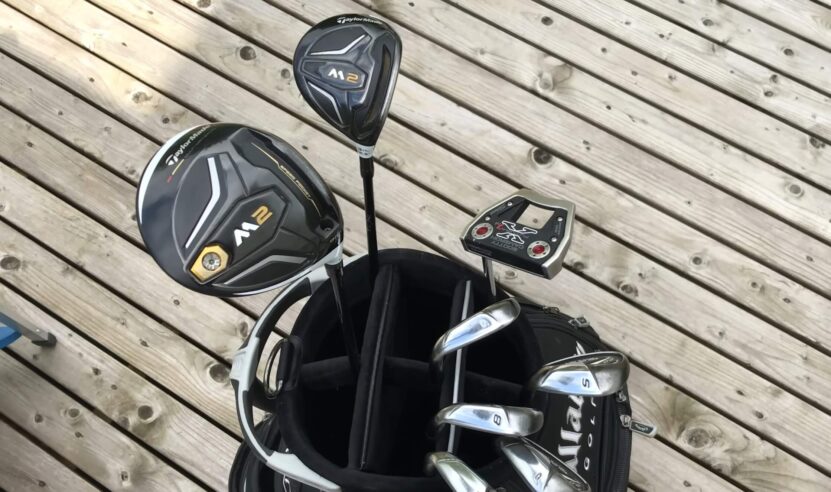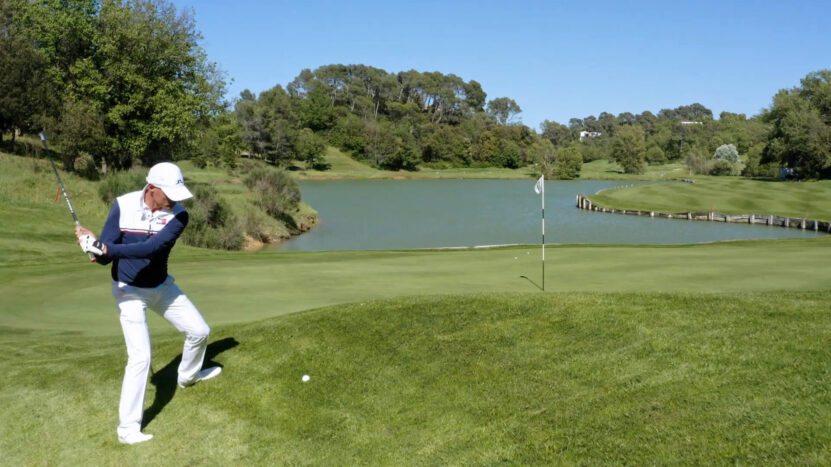Playing golf in the wind takes more than just luck; it demands smart choices and small adjustments. Knowing how wind affects your shots, picking the right club, and keeping your ball low can turn a windy day into a rewarding challenge.
Instead of swinging harder, staying calm and making precise changes will help you hit more controlled shots.
Also, check out some tips for playing golf in cold weather.
1. How Wind Changes Your Game?
Playing in the wind dramatically alters how your ball behaves in the air. Wind impacts trajectory, spin, and distance. For example, a headwind can significantly reduce the distance of your shot by adding extra resistance, causing the ball to balloon and fall short.
Conversely, a tailwind can carry the ball farther than expected but might reduce spin, causing less control on the green.
- Headwind: Adds resistance, requiring more club and a lower trajectory.
- Tailwind: Reduces resistance, so less club is needed, but less spin can lead to uncontrolled shots.
- Crosswind: Pushes the ball left or right, forcing you to adjust your aim.
2. Pick the Right Club When Playing Golf in the Wind

Selecting the correct club in windy conditions is crucial for maintaining control. When hitting into the wind, choose one or two clubs more than usual. This helps to counteract the wind’s resistance.
On the other hand, when the wind is behind you, consider using one less club, as the wind will carry the ball further.
- Into the wind: Use more club than normal.
- Downwind: Use less club, but remember that the ball will roll further.
- Crosswind: Stick with the usual club but adjust your aim to compensate for the wind’s push.
3. Adjust Your Swing in the Wind
Your swing should adapt to the conditions, especially in the wind. A smooth, controlled swing works better than trying to overpower the wind, which can lead to increased spin and an unpredictable ball flight. Keeping the ball low by making small adjustments is key.
- Grip: Choke down on the club to gain more control.
- Ball Position: Move the ball slightly back in your stance to hit it lower.
- Finish: Aim for a lower follow-through to reduce the ball’s height and keep it out of the wind.
4. Control the Ball Flight for Better Results

In windy conditions, controlling your ball flight is essential. Keeping your ball low can minimize the wind’s impact and help you achieve more accurate shots. You don’t want the ball to balloon high into the air where the wind can wreak havoc.
- Low Trajectory: Position the ball slightly back in your stance and swing smoother. A lower finish will help you keep the ball flight low.
- Reducing Spin: Less spin means less lift, which is ideal when playing into the wind. Take one more club, choke down slightly, and swing at 80% power to reduce unnecessary spin.
- Wind Awareness: Adjust your shots based on the wind direction. Practice controlling the ball flight on windy days to improve your confidence.
5. Play Into a Headwind
Headwinds can be one of the toughest challenges on a golf course. They require you to be strategic with club selection and swing technique. Playing golf in the wind slows down your ball and causes it to fly shorter, so adjustments are crucial.
- Club Selection: Take at least one more club than usual. For example, if you’d typically hit a 7-iron, consider using a 6-iron instead.
- Ball Position: Place the ball further back in your stance to hit it lower, which reduces the impact of the headwind.
- Swing: Focus on a smooth, controlled swing rather than hitting harder. Swinging harder often increases spin, making the ball balloon and fall short.
6. Take Advantage of a Tailwind
A tailwind can help increase your distance, but it also reduces the spin on the ball, which may affect your control around the greens. When playing golf in the wind, focus on maximizing the wind’s advantage while keeping your accuracy.
- Club Selection: Take one less club, as the wind will carry the ball further. For example, if you would typically hit an 8-iron, try a 9-iron instead.
- Ball Flight: A higher ball flight can take advantage of the tailwind, but be cautious about overshooting the green due to reduced spin.
- Greens: Expect less backspin when the ball lands, meaning it will roll out further than usual. Adjust your shot accordingly to avoid overshooting your target.
7. Deal with Crosswinds on the Course
Crosswinds can be tricky as they push the ball sideways, forcing you to adjust your aim. To manage crosswinds effectively, it’s important to know how the ball will react based on your shot shape. Adjusting your stance and swing can help you stay in control.
- Aim: Aim slightly into the wind to compensate for its push. For example, if the wind is blowing left to right, aim slightly left.
- Shot Shape: Use the wind to your advantage by shaping your shot into the wind. For example, play a draw into a left-to-right wind or a fade into a right-to-left wind.
- Club Selection: Stick with your usual club, but focus on accuracy. Crosswinds affect direction more than distance, so controlling the ball flight is key.
8. Tips for Maintaining Stability in High Winds
Stability is crucial when playing golf in the wind to maintain control over your shots. A firm stance and strong balance help prevent the wind from affecting your swing and results.
- Widen Your Stance: A wider stance lowers your center of gravity, providing more balance and stability in high winds.
- Grip the Club Firmly: A stronger grip helps prevent the wind from interfering with your swing, giving you more control.
- Stay Low: Keep your body more grounded by slightly bending your knees and leaning into the wind. This will help you stay steady through your swing.
9. Handle Wind Around the Green

Wind can influence more than just long shots. When you’re around the green, it’s important to account for the wind when chipping or putting.
- Chipping: Use lower lofted clubs for bump-and-run shots to keep the ball closer to the ground, minimizing the wind’s effect.
- Putting: Wind can affect your putt’s direction, so adjust your aim slightly depending on the wind’s strength and direction. Focus on striking the ball firmly to avoid the wind pushing it off course.
- Wind Breaks: Look for natural windbreaks like trees or hills around the green to help reduce the wind’s impact on your shot.
10. Common Mistakes to Avoid in Windy Conditions
Playing in the wind can throw off even seasoned golfers. There are common mistakes that tend to pop up when the wind is blowing hard. Avoiding these pitfalls will keep you from losing strokes unnecessarily.
- Swinging Too Hard: Many golfers think swinging harder will counteract the wind. In reality, swinging harder usually creates more spin, making the ball balloon up and lose distance.
- Not Adjusting Ball Position: Failing to move the ball back in your stance when hitting into the wind leads to higher ball flights, making your shots more vulnerable to the wind.
- Ignoring Crosswinds: Forgetting to adjust your aim in crosswinds will push your ball further off-target. Always aim slightly into the wind to stay on track.
11. Stay Calm and Focused During Windy Rounds
Windy conditions can test your patience, but staying calm and maintaining focus is essential to success on the course. Wind is an equalizer, affecting every golfer, but keeping a cool head helps you execute your strategy better.
- Breathe and Reset: Between shots, take a moment to reset your mind. Let go of frustration and focus on your next move.
- Stick to Your Routine: Maintaining a consistent pre-shot routine helps calm nerves and keeps you focused on the task at hand, regardless of the wind.
- Manage Expectations: Windy days may lead to higher scores. Accept that it might not be your best round and focus on making smart decisions.
12. Practice Techniques for Windy Days
Practicing in windy conditions will help you feel more comfortable when those days inevitably arrive on the course. You’ll develop the confidence to execute shots under pressure.
- Hit Lower Shots: Head to the range and practice keeping the ball low. Use clubs with less loft and focus on a controlled swing to reduce the wind’s impact.
- Work on Different Wind Directions: Practice hitting into headwinds, tailwinds, and crosswinds. This will teach you how the ball reacts and how to adjust your game.
- Improve Your Balance: Spend time working on maintaining stability during windy conditions. A strong, balanced stance helps minimize the wind’s effect on your swing.
13. How Wind Affects Different Clubs
Wind impacts each club in your bag differently. Understanding how wind interacts with various club types helps you make smarter decisions during your round.
- Driver: Wind amplifies any mistakes with the driver due to the club’s lower loft and longer distance. A headwind will reduce distance significantly, so tee the ball lower and swing with control. A tailwind can help you gain extra distance but may reduce spin, causing less control.
- Irons: Lower lofted irons are less affected by the wind compared to higher lofted wedges. When hitting into the wind, consider using one or two more clubs and keeping the ball low.
- Wedges: Wind heavily impacts wedges due to their high loft. When playing into the wind, opt for bump-and-run shots instead of full wedge shots to minimize the wind’s influence.
14. Maximize Distance with the Wind on Your Side

When the wind is in your favor, you can take advantage to gain extra yards. However, it’s important to manage your shot carefully to avoid overshooting or losing control.
- Club Selection: Use one less club than usual when hitting downwind. The wind will carry the ball further, so you won’t need as much loft.
- Trajectory Control: While the wind can increase distance, it can also reduce spin, leading to less control. A higher trajectory might be useful to maximize distance, but make sure you are aware of the extra roll you’ll get on the green.
- Planning for Roll: Expect more rollout when hitting downwind. Aim for a spot shorter than your actual target, especially when approaching the green.
FAQs
How Can You Gauge Wind Strength Without a Device?
You can gauge wind strength by observing natural elements around you. Look at tree tops, flagpoles, or even the direction clouds are moving. Another common trick is to toss a few blades of grass into the air to see which way the wind is blowing and how strong it is. This can help you make quick, informed decisions when selecting a club.
How Do Professional Golfers Play in the Wind?
Professional golfers often use a combination of lower ball flights, controlled swings, and precise club selection when playing in the wind. They practice hitting shots that minimize spin and take advantage of wind direction. Staying calm and focusing on shot placement is a key strategy for pros when facing windy conditions.
What’s the Best Ball Type for Windy Conditions?
Some golfers prefer using balls with lower spin rates when playing in the wind. A lower spin rate helps reduce the chance of the ball ballooning in the air and being more affected by wind gusts. Harder balls with firmer covers tend to generate less spin, making them a better choice for controlling shots in windy conditions.
Can You Practice Golf in The Wind on Indoor Simulators?
Yes, modern golf simulators allow players to adjust wind conditions during practice. Simulators can mimic different wind strengths and directions, giving you the chance to work on various shot types without needing to wait for a windy day on the course. This type of practice can improve your confidence when playing in real windy conditions.
Final Thoughts
Playing golf in the wind can be both challenging and rewarding. The key is staying adaptable, making smart club choices, and controlling your ball flight. Every round in the wind is an opportunity to sharpen your skills and learn how to handle adverse conditions.
- Stay Patient: Wind can make even simple shots more difficult, so keeping calm and accepting the challenge will help you perform better.
- Practice in the Wind: Spend time practicing on windy days to build confidence and develop a feel for how the wind affects your shots.
- Enjoy the Challenge: Windy conditions can level the playing field, making it less about power and more about strategy and control.

